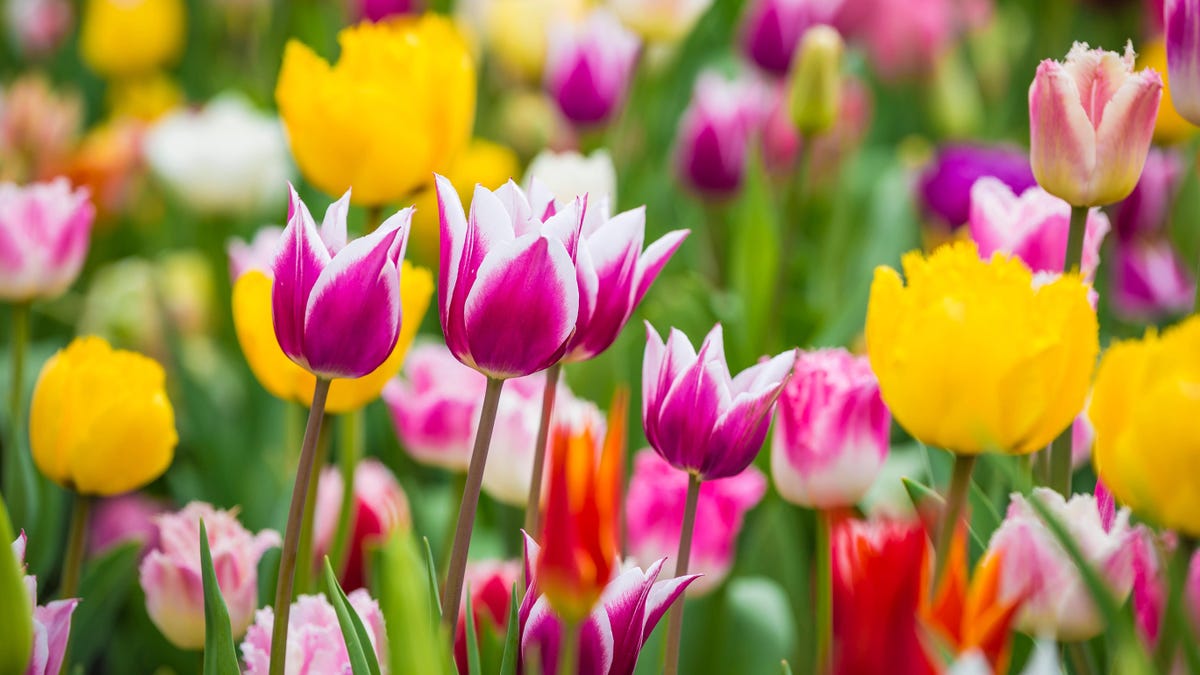Why You Should Order Spring Bulbs Now

Winters are long, dark, wet and cold. When the first buds of spring flowers begin to bloom in March, it’s like a dopamine rush, giving us all hope that the sun will someday come out again. But what happens in late spring, when we enjoy the six gorgeously predictable colors of spring, is like a horticultural marketing campaign.
First the daffodils start peeking out, spraying the yards with a band of sunny flowers ranging from yellow to peach. This is followed by irises with bearded necks in blue, purple and red. Soon after, peonies appear like fluffy clouds of pink and white perfume that require you to stick your entire mug in them. In late spring, ranunculi bloom like branches of bright roses. But it’s the tulips that really make the difference – and if you time it right and plan a little, tulips can be the mainstay of spring and create a colorful story all over your yard.
The problem is, with all the inspiration you get from spring flowers, you can’t just run to the nursery and plant them right away. Spring flowers go to the ground like bulbs in autumn, and by the end of summer, when it’s time to order bulbs, and in the fall, when you plant them, your memory of awe and wonder that you felt in spring will fade.
Most bulbs are grown and harvested overseas and will take time to import into the US, which is why the catalogs have just hit the mailboxes.
Time is everything
We tend to look at our yards as stationary objects: “I can’t plant a plant here because hostas grow there,” rather than as an ever-changing landscape depending on the season. Bulbs rise at different times and then leave, leaving room for other plants. Most people put in light bulbs piecemeal, some here, some there, without much planning, and there’s nothing wrong with this method. But understanding the timing of spring bloom can help you make a real color story. There are late winter, early, mid and late spring bulbs, and ideally you want to consider bulbs from each of these time ranges so that you have consistent flowering throughout the season. Even among tulips, there are early, mid and late flowering tulips, and by choosing from each group, you get many weeks of color instead of just one or two.
When you’re thinking about your yard, it’s helpful to jot down a little planning calendar. Photos of all bulbs can be found on the bulb websites. My favorite three are Eden Brothers, Holland Bulb Farms and Brecks.
Think Height
From undersized crocuses to skyscraper alliums, there is a lot to consider in terms of placement when it comes to bulbs. You want the taller bulbs to not hide the shorter bulbs from the curb, and you can also use those really tall bulbs as exclamation marks in your landscape. Consider whether you want the flowers to be in graduated layers or small clusters, and keep in mind the timing of flowering.
Consider painting your yard with bright colors.
The most important choice you make with spring flowers is color. Some bulbs, such as allium, only come in a limited range of blue to purple. But in the world of irises and tulips, there are plenty of flowers to choose from.
However, I encourage you to ditch the random packs (although it’s a flashy deal) and opt for a color theme. For example, I decided to use a color band from purple to orange. So I chose red, magenta, magenta and orange and didn’t deviate from those colors. I decided that the flowers would create an ombre effect throughout the yard, so I started with red on the far left bank and then up to orange on the right. To implement this idea, I set up a small graph as shown below. The effect is amazing.
Eden Brothers, in particular, specializes in colored light bulb packages, which I find particularly attractive. I’m obsessed with their Cherry Pie ranunculus blend; their Passion Mix Tulip was a show stop next to my front door. Breck’s Cranberry Apple Texture Mix is stunning, and Holland Bulb’s Candy Stripe is like someone screaming in your yard, “Look at me!”
Fill in the gaps year after year
Since you can’t tell where you’ve planted your spring flowers when you’re going to plant new ones each fall, I find photographing flowers each spring very helpful so I know where to fill in the gaps. In my second year, I added a secondary color band of yellow and orange, and added densely planted bulbs elsewhere, such as near my front door.
While professional growers change bulbs year after year, if you take proper care of your bulbs, you will consistently earn high profits. Bulbs need their leaves and stems, even after you tie the flowers, to get enough energy to bloom again the following spring, which means letting them wilt in place. Come fall and we’ll dive into how to plant them successfully. Once you place an order, your bulbs will go on sale in September.